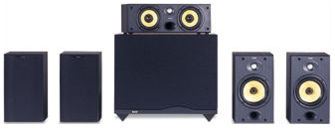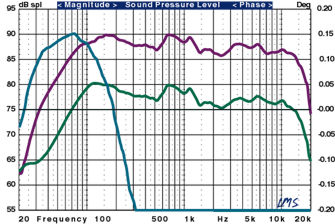Speaker-Roundup Rodeo B&W 600 Series 2
When most folks hear the company name B&W, they think high-end . . . and they think "out of my price range." It has taken more than two decades for B&W to build that reputation, and they have done so through their quality speakers and not through marketing hype.

Even a quick glance at the B&W 600 Series 2 speakers gives the impression that this speaker ensemble is both high-end and a true B&W. Several years ago, B&W implemented the use of Kevlar cone drivers in their speakers and quickly became known for their "yellow speaker" look. Would you believe that those same Kevlar cone drivers are in B&W's entry-level speaker ensembles?
The 600 Series 2 speaker ensemble matches four small bookshelf speakers with a center channel and subwoofer. Each of the four DM601 S2 speakers features a single 1-inch titanium-dome tweeter on top of a single 6.5-inch woven Kevlar midwoof in a frontward-firing ported enclosure. The exterior of the front baffle has several hundred dimples that not only look stylish but—according to B&W—also diffuse or eliminate the secondary sound waves associated with all speakers. The cabinets on these speakers are rather plain, so I'd probably display them without the grilles for more sex appeal.
On the rear panel of the speaker, there are binding posts for connectivity, but there's no threaded insert for bracket-mounting applications.
The CC6 S2 center channel is a simple horizontal design, with two 5-inch woven Kevlar woofers flanking a 1-inch aluminum tweeter above an oblong frontward-firing port. There's no base plate included for adjusting the direction of the sound, nor is there a threaded bracket insert on the rear for mounting.
![]() The ASW1000 subwoofer in the B&W system is built very well. Again, it's a rather plain-looking enclosure—square, with not much to speak of other than a frontward-firing 10-inch woofer and a huge downward-firing dimpled port underneath. The internal amplifier is rated at 120 watts. On the back panel are variable crossover, gain control, phase-shifting, and both high and low ins/outs.
The ASW1000 subwoofer in the B&W system is built very well. Again, it's a rather plain-looking enclosure—square, with not much to speak of other than a frontward-firing 10-inch woofer and a huge downward-firing dimpled port underneath. The internal amplifier is rated at 120 watts. On the back panel are variable crossover, gain control, phase-shifting, and both high and low ins/outs.
There's something about a B&W speaker that sets it apart from all other speakers—besides its yellow drivers, that is. That something is its sound. I was both amazed and delighted to hear that B&W had not sacrificed sound quality when they built this ensemble.
I began first with the Hell Freezes Over DVD and listened intently. The main left/right speakers were able to reproduce the guitars effortlessly, while the center laced in the vocals. The top end seemed especially detailed and precise, without getting too bright. Sound like this is only engineered through proper crossover design, which isn't a startling revelation; I only point this out because it's typically the first thing sacrificed when companies build a budget-oriented speaker.
Vocals were absolutely wonderful through the B&W system. In the back of my mind, I kept comparing them to my $10,000 speakers at home—I must've listened to this disc 100 times on my system, and I found the B&W ensemble's sound to be very similar.
I also noted and was very pleased with the tight, punchy bass and midbass the DM601s produced in harmony with the ASW1000 subwoofer. The sound was very accurate, and there was no gap (or hole) between the sub and satellites.
At higher volume levels, I was able to detect a bit of port noise coming from the front and center-channel speakers, but it wasn't anything I couldn't live with in consideration of the overall sound. I was so involved in the music, I almost listened to the entire disc before realizing I was supposed to continue the review.
Next, I loaded up my The Mask of Zorro DVD. The first track on this disc is fantastic if you haven't heard it (I highly recommend you do). The low-frequency extension runs parallel to some snappy finger cymbals, and the result is quite pleasurable with the right speakers. The DM601s were no exception. As the track opened, the ASW1000 subwoofer came alive, with a ferocious attack of the lower bass line. The ASW1000 is a very impressive-sounding 10-inch sub by any standards.
The onscreen action and dialogue generated through the CC6 were crisp and uncolored, but that hint of port noise kept the speaker from reaching out farther. At any rate, the sound would be more than adequate for a 900-square-foot theater.
The rear-channel speakers were able to produce big sound but were very directional at times. This speaker is certainly the weakest link in the chain, but only because of its directionality.
I inserted the Starship Troopers DVD to see how the B&Ws would handle a lot of action. The CC6 produced very accurate dialogue at low to Dolby-reference volume levels, and the ASW1000 subwoofer delivered low frequencies with authority. There were times when I thought I'd have to back it off a bit, but the sub never seemed to fatigue.
The 600 Series 2 speaker ensemble from B&W is by far the most impressive system in this price range that I've heard in the past year. It's rare to find a system at this price point that's capable of outstanding performance in both music and cinema modes. For those of you who are in the market for a well-priced theater speaker ensemble and still love your music, the 600 Series 2 is tough to beat.
HT Labs Measures: B&W 600 Series 2

This graph shows the quasi-anechoic (employing close-miking of all woofers) frequency response of the B&W's DM601 S2 mains/surrounds (top trace), ASW1000 subwoofer (upper-left trace), and CC6 S2 center channel (lower trace). All passive loudspeakers were measured at a distance of 1 meter with a 2.83-volt input and scaled for display purposes.
On-axis response of the DM601 S2 L/R measures +1.9/-2.3 dB from 200 Hz to 10 kHz. The -3dB point is at 65 Hz, and the -6dB point is at 52 Hz. Impedance reaches a minimum of 4.61 ohms at 198 Hz and a phase angle of -53.54 degrees at 3.2 kHz. Sensitivity is 88 dB from 600 Hz to 2 kHz.
On-axis response of the CC6 S2 center measures +1.8/-2.8 dB from 200 Hz to 10 kHz. The -3dB point is at 70 Hz, and the -6dB point is at 57 Hz. Impedance reaches a minimum of 4.56 ohms at 188 Hz and a phase angle of -45.22 degrees at 111 Hz. Sensitivity is 88 dB from 600 Hz to 2 kHz.
Close-miked response of the ASW1000 subwoofer, normalized to the average level from 40 Hz to 80 Hz, indicates the lower -3dB point is at 34 Hz and the -6dB point is at 29 Hz. The upper -3dB point is at 115 Hz.—AJ

























































